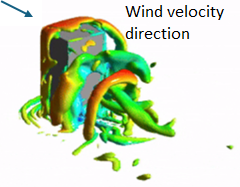In this case study we hear from Jose Romero, a PhD student in Civil Engineering, who has been using BlueBEAR to predict wind characteristics around high-rise buildings.

You probably don’t realise it, but wind is probably influencing your actions on a daily basis! It may be that you choose to grab a coat before leaving for work, it may be that you avoid walking past a certain road because you know it tends to be gusty, or it may be that you brush your hair again once you get to work!
On a more serious note, extreme wind related events are thought to have caused most of the economic losses due to natural disasters in the world. This problem will be further accentuated by global warming. With the drive of planning authorities towards high density urban areas with tall and slender buildings, these become more vulnerable to wind.
Thus, wind engineering focusses on developing an understanding of the effects of wind in the built environment or on structures, and how to mitigate the risks associated with it. This may be through analysing wind impact of structures, discomfort to pedestrians due to gusts of wind, ventilation systems of buildings or air quality and pollutant dispersion around buildings, to name a few.
…if I try running these simulations on my personal desktop computer, it may take months or years before it finishes (if it even gets to start)! Alternatively, with BlueBEAR, the waiting time cuts down to hours or days. Yes, BlueBEAR is the cornerstone to my research.
An example of the importance of having a thorough understanding of the flow field around a high-rise building is Bridgewater place. On the road immediately next to the skyscraper, baffle boards were erected to reduce wind amplifications at street-level, after a devastating accident occurred in 2018. In fact, in 2019 the City of London formally adopted a set of guidelines aimed at limiting the impact of new high-rise development on pedestrians and cyclists at street level.

Can you see why our research is so important? So, what do we do?
The physical behaviour of fluid flows is described by the Navier-Stokes equations. In principle, we could just solve the equation and then have an answer to any problem at stake. But there is one problem. This is an awful set of equations to solve for an exact solution. In fact, there is no proof that a solution always exists – hence there is a $1,000,000 prize (Millennium Prize) to whoever proves that smooth solutions always exist.

So instead, we use numerical methods to solve the Navier Stokes equations by means of some approximations and assumptions. We turn the full differential equations into a system of linear equations. Once solved, interesting field values such as velocity or pressure can be obtained at discrete locations: Computational Fluid Dynamics (CFD).

Where does BlueBEAR come into play? CFD simulations can be MASSIVE. I usually work with problem sets with 10-60 million of cells. In other words, if I try running these simulations on my personal desktop computer, it may take months or years before it finishes (if it even gets to start)! Alternatively, with BlueBEAR, the waiting time cuts down to hours or days. Yes, BlueBEAR is the cornerstone to my research.
The BlueBEAR team is very helpful, their documentation is awesome, and they continuously organize workshops which are extremely useful and educational.
BlueBEAR is a cluster computing system which delivers immensely higher performance than my personal workstation. With BlueBEAR, I can request hundreds of CPUs to accelerate the simulation. Memory is also key in CFD, and generally I demand 1-3 TB! Totally unfeasible with a typical workstation. The data storage capabilities of BlueBEAR are incredible too, allowing myself and other colleagues to produce and store large datasets of results. But BlueBEAR is much more than that. The BlueBEAR team is very helpful, their documentation is awesome, and they continuously organise workshops which are extremely useful and educational. Essentially, I would not be able to do my PhD without BlueBEAR.
We were so pleased to hear of how Jose was able to make use of what is on offer from Advanced Research Computing, particularly to hear of how he has made use of BlueBEAR HPC and its many cores – if you have any examples of how it has helped your research then do get in contact with us at bearinfo@contacts.bham.ac.uk. We are always looking for good examples of use of High Performance Computing to nominate for HPC Wire Awards – see our recent winners for more details.
